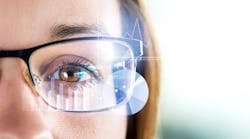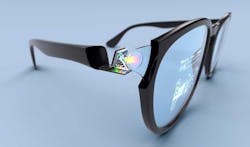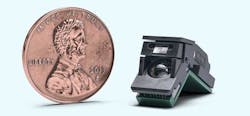This article is part of the TechXchange: Advanced Display Technology.
Members can download this article in PDF format.
What you’ll learn:
- How LBS technology enables a compact, power-efficient, and bright display engine.
- How MEMS-based LBS compares to panel-based display technologies.
- What’s the difference between the one-chip and two-chip solutions?
Billions of U.S. dollars have been invested in display technology for augmented-reality (AR) glasses (Fig. 1). However, from startups to tech giants, companies have failed in delivering truly wearable consumer AR glasses. Some have confined themselves to enterprise or military solutions.
The available headsets suffer from major limitations, particularly their price point, bulkiness, and restriction to indoor use. These all come down to mainly one factor—display technology.
An adequate display solution has yet to be developed, so, some consumer wearable companies are creating workaround AR for their headsets. Cameras record the user’s surroundings and digitally reproduce the scenery on the display of a closed system, which can then be augmented with digital content. One solution goes to the lengths of displaying the user’s eyes, or some digital form of them, on another display, facing the outside world.
What they’re all striving to achieve, though, is something else: Glasses through which you can see your real, actual surroundings and digital content at the same time, indoors or outdoors, hassle-free. There can be two different types of these glasses—a 2D, monocular smartglasses version to display rather sparse information, mostly text, and a 3D, binocular version for more immersive experiences that blend real with digital content.
Manufacturers have to meet a number of display-related challenges on the path to either one of the two types of AR glasses. This article defines those challenges and evaluates the different display solutions in this context. It explains how MEMS-based LBS technology is used in optical applications and discusses its advantages for AR displays.
Challenges in Building Displays for AR Glasses
Building truly all-day, wearable consumer AR glasses involves several requirements for the display technology.
There’s the issue of social acceptance. The user wants to feel comfortable wearing the glasses among other people. This requires that the glasses look stylish, very similar to a normal pair of glasses, and offer design choices to the user.
Moreover, direct eye contact between the wearer and his/her environment needs to be possible, which calls for see-through lenses as opposed to a display facing the outside world, i.e., people looking at the wearer. The lenses must not project a large part of the light away from the user’s eyes, lighting up the display and thus preventing direct eye contact, so-called eye glow.
Usability demands an operating time of at least eight hours, so that the user can wear the glasses for a long time without having to recharge them. For outdoor use, the projected images need to be very bright and high contrast to be able to compete with direct sunlight.
The wearer of the 3D, binocular version will want to experience a wide range of colors (color gamut) and high-resolution images with a large field of view (FOV), while the smartglasses version must deliver crisp text. The glasses’ eye-box must be an acceptable size, meaning it should not be difficult to locate the glasses in the right position on the nose whereby the user’s eyes get to see the entire virtual image and not a cropped version. Consumer AR glasses also have to be a reliable product with an acceptable product obsolescence, especially if they were to be daily companions.
In terms of comfort, the glasses should not exceed a weight of 80 grams (adding only slightly to a pair of standard glasses). And the heat development in the temples must be kept to a minimum so that there’s no discomfort for the user.
Lastly, the glasses need to have a reasonable price tag and be affordable to a relatively large number of consumers.
When combined, these requirements translate to the following challenges for AR display technology, where the display engine needs to:
- Be lightweight and small enough to fit into the temples of the glasses and leave enough room for other necessary components.
- Have very low power consumption for longer operating times and very high efficiency for minimal heat generation.
- Deliver sufficient brightness and contrast for outdoor use.
- Deliver high-resolution images with wide color gamut.
- Deliver fast image build-up.
- Deliver large FOV.
- Come with sufficient reliability for a long product lifespan.
- Use materials and a production process that provide for an affordable price (of the end product).
The issues of eye glow and eye-box size don’t relate to the display engine, but rather to the used optical combiner (see below).
Display Technologies for AR Glasses
Common display technologies for augmented reality are OLED, microLED, LCoS, and DLP:
- OLED (organic light emitting diode) is a self-emissive technology that can deliver high-resolution images. However, it doesn’t deliver the necessary brightness for outdoor use and competition with direct sunlight, rendering it practically unfeasible for use in consumer AR glasses.
- MicroLED is another additive display solution, only creating light where it’s needed. It’s efficient for low-resolution images, but for a higher pixel resolution, it involves pixel pitch reduction. Aside from increasing in size, this means considerably lower efficiency and output brightness. The technology involves significantly high manufacturing costs and isn’t producible in high yields.
- LED-based LCoS (liquid crystal on silicon) is an inherently subtractive technology. It involves a constant maximum backlight on top of a liquid-crystal matrix to subtract the amount of light that’s not needed for the displayed image. The subtracted, black areas are converted into heat. This essentially wastes a lot of already generated light and energy.
- DLP (digital light processing) has the same shortcomings as LCoS in that it’s also a subtractive technology. Both need an LED source and further illumination optics, adding to the system’s size.
All of the above technologies need additional optics behind the panel, for projecting into a waveguide, and sometimes in front of it. This adds to the system’s overall size.
In terms of resolution, these panel-based approaches need to increase size to boost resolution, meaning they must add more pixels to the panel. However, another, non-panel-based approach doesn’t need to increase size.
MEMS-based laser-beam-scanning (LBS) systems offer several advantages for consumer AR glasses. The FOV or scanning angle of the MEMS mirror, hence the resolution, can be increased with the same chip size. The mirror needn’t become larger to achieve more pixels (Fig. 2).
LBS and MEMS enable a level of miniaturization that allows for more compact light engines, which can fit into smaller wearables without additional illumination or projection optics. LBS is an additive technology—the lasers aren’t switched on for a dark image, which means a more efficient energy output. This efficiency is a key enabler for longer operating times.
Furthermore, LBS generates enough brightness for outdoor use of the glasses with very low power consumption.
MEMS-Based Laser Beam Scanning for Optical Apps
Microelectromechanical systems are used in a wide variety of applications, ranging from inkjet printers (using piezoelectrics for depositing ink on paper) to smartphones (e.g., MEMS microphones or accelerometers) to cars or airplanes (e.g., for airbag deployment, electronic stability control, or an airplane’s autopilot).
In principle, MEMS incorporate all of the technologies and techniques needed to manufacture integrated electronic circuits. They use the same substrate—silicon—but as a mechanical instead of an electronic material. This enables components to move and have suspension; hence, MEMS structures can be used as sensors and actuators.
One main characteristic of MEMS for optical applications is the synchronization of their mechanical movement with a laser source. MEMS mirrors can be used in LBS systems to deflect laser beams and produce images. Three laser beams—red, green, and blue for the full color spectrum—get collimated and combined through lenses or beam combiners. The combined beam hits the mirror, the mirror scans back and forth (horizontally and vertically) and gives rise to an image.
In the case of AR glasses, this light is guided through an optical combiner component in the glasses, a waveguide. The waveguide displays the virtual image to the human eye, overlaying it on top of the real-world scenery.
Depending on which type of waveguide is used, reflective vs. diffractive vs. holographic, there are tradeoffs between eye-box size and efficiency (eye glow), operating time, and heat development. This article concentrates on the display engine and will not discuss solely waveguide-related issues. The integration of the optical combiner with MEMS-based LBS solutions does require more research and development because of the focus on panel-based approaches.
LBS systems traditionally involve two oscillating mirrors on two single axes of two separate chips that need to be accurately aligned. However, the solution with both axes implemented on a single chip lowers the overall need for alignment of the optical system.
The one-chip solution requires a highly sophisticated MEMS design and manufacturing process to avoid dynamic deformation of the mirror plate. Typical scanning frequencies are in the range of 35 to 40 kHz, which involves rather high inertial forces acting on the mirror plate.
Benefits of MEMS LBS
The biggest benefit versus the two-chip solution is a significant reduction of the system’s size. There are optical advantages, too. Operating the single 2D mirror with two resonant axes at high frequencies results in a very particular scan pattern (Lissajous as opposed to raster scanning), allowing for much smoother motion rendering, faster image build-up, as well as greatly reduced artifacts in the 3D perception of fast-moving objects.
Encapsulating the mirror in a miniature vacuum ensures long-term reliability. Furthermore, it reduces damping or friction losses, resulting in increased achievable oscillation amplitude and optical resolution that in turn leads to lower power consumption and better optical performance.
There are many overall advantages of this solution. MEMS connote mass producibility and low manufacturing costs. MEMS-based LBS display engines don’t need additional illumination or projection optics, which leads to a lightweight engine, not even the size of a sugar cube.
Furthermore, the MEMS mirror and driver can be designed to consume less than 10 mW, ensuring minimal heat generation and enabling long operating times while guaranteeing the mirror moves very fast and with a very high FOV. And MEMS mirrors developed for this particular application can support a FOV of up to 110 degrees diagonally, enabling a 4K display.
The LBS system only produces light where it’s needed which results in extremely high contrast. Plus, there’s no energy waste due to absorption or subtraction. Certain algorithms and video electronics synchronize the intensity modulation of the red, green, and blue laser diodes according to the instantaneous position of the deflected laser beam. This generates a high-resolution, high-contrast, and high-brightness image, pixel by pixel. A safety shutdown and adjusted laser power ensure eye safety at all times.
With a display brightness of 2 to 3 million nits, this system delivers enough brightness whereby it can be used outdoors. For comparison, the sun at noon is rated at 1.6 billion nits and you need at least 3,000 nits to the eye for outdoor use of a display. For a diffractive waveguide to deliver these 3,000 nits, you need an estimated 2 to 3 million nits from the display.
Conclusion
Laser beam scanning shows considerable advantages over the OLED, microLED, LCoS, and DLP panel-based approaches in terms of achievable engine form factor and weight, energy efficiency, brightness, and contrast. This makes MEMS-based LBS display engines key to enabling stylish, lightweight, affordable, and powerful consumer AR glasses.
The technology provides high-quality projections of text and images with a large field of view, making it suitable for different types of AR spectacles, 3D binocular glasses, or 2D monocular smartglasses. It’s the only technology delivering enough brightness to enable outdoor use of these glasses.
MEMS-based LBS display engines offer reliability and mass producibility. They will likely be adopted for different products beyond consumer wearables, too, including automotive applications like head-up displays, or advertising panels. Another use case is 3D scanning of the environment, either in 3D cameras or 3D sensors for MR/AR glasses.
Augmented-reality glasses through which you can see your real, actual surroundings and digital content at the same time, indoors or outdoors, hassle-free, are possible with MEMS-based LBS.
Read more articles in the TechXchange: Advanced Display Technology.


